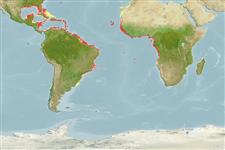Common names from other countries
>
Eupercaria/misc (Various families in series Eupercaria) >
Gerreidae (Mojarras)
Etymology: Eucinostomus: Greek, eu = good + Greek, kyon = dog + Greek, stoma = mouth (Ref. 45335).
More on author: Bleeker.
Environment: milieu / climate zone / depth range / distribution range
Ecologia
marino; acqua dolce; salmastro demersale; amfidromo (Ref. 51243); distribuzione batimetrica 0 - 25 m (Ref. 2683). Subtropical; 33°N - 34°S, 98°W - 14°E
Eastern Atlantic: west African coast, from Senegal to Angola (Ref. 57394). Also reported from Mauritania (Ref. 5377, 7352). Western Atlantic: Bermuda and Florida, USA to Brazil; not found in the Bahamas (Ref. 7251).
Size / Peso / Age
Maturity: Lm ? range ? - ? cm
Max length : 30.0 cm TL maschio/sesso non determinato; (Ref. 2683); common length : 23.0 cm TL maschio/sesso non determinato; (Ref. 2683); peso massimo pubblicato: 26.50 g (Ref. 118626)
Spine dorsali (totale) : 9; Raggi dorsali molli (totale) : 10; Spine anali: 3; Raggi anali molli: 7 - 8. Diagnosis: body fusiform and compressed; snout pointed; mouth strongly protrusible; nostrils contiguous, positioned nearer to eye than to snout tip; dorsal fin deeply notched; tips of pectoral fins not reaching to anal-fin origin; scales cycloid on head and finely ctenoid on body; scales of interocular space reaching anterior border of eyes; tip of spinous dorsal fin with a black spot, underlined by a whitish band (Ref. 57394).
Coloration: back olivaceous, sides silvery; a characteristic black spot at tip of spiny part of dorsal fin; young individuals may show dark vertical bars on back and sides (Ref. 57394).
A coastal species entering estuaries, lower courses of coastal rivers, and lagoons (Ref. 4323, 7352, 57394). Found over sand or mud bottoms (Ref. 3722, 57394). Feeds on fish, shrimps, mollusks, zooplankton and detritus (Ref. 28587); including other benthic crustaceans and polychaetes. Forages at daytime in small groups, hovering close to the bottom and either picks off prey on the substrate or digs into it sifting the mouthed sediment through its opercular openings. Its conspicuous black tip on dorsal fin is mimicked by juvenile guianan snooks, Centropomus mexicanus, an example of aggressive mimicry (Ref. 43465). Marketed fresh but not highly esteemed (Ref. 3722).
Life cycle and mating behavior
Maturities | Riproduzione | Spawnings | Egg(s) | Fecundities | Larve
Roux, C., 1990. Gerridae. p. 781-782. In J.C. Quero, J.C. Hureau, C. Karrer, A. Post and L. Saldanha (eds.) Check-list of the fishes of the eastern tropical Atlantic (CLOFETA). JNICT, Lisbon; SEI, Paris; and UNESCO, Paris. Vol. 2. (Ref. 7352)
IUCN Red List Status (Ref. 130435)
CITES (Ref. 128078)
Not Evaluated
Threat to humans
Harmless
Human uses
Pesca: scarso interesse commerciale
Strumenti
Special reports
Download XML
Fonti Internet
Estimates based on models
Preferred temperature (Ref.
115969): 23.4 - 28, mean 27.1 (based on 1079 cells).
Phylogenetic diversity index (Ref.
82804): PD
50 = 0.5010 [Uniqueness, from 0.5 = low to 2.0 = high].
Bayesian length-weight: a=0.01047 (0.00829 - 0.01322), b=3.08 (3.04 - 3.12), in cm Total Length, based on LWR estimates for this species (Ref.
93245).
Trophic level (Ref.
69278): 3.2 ±0.45 se; based on food items.
Resilienza (Ref.
120179): Alto, tempo minimo di raddoppiamento della popolazione meno di 15 mesi (Preliminary K or Fecundity.).
Fishing Vulnerability (Ref.
59153): Low vulnerability (20 of 100).
